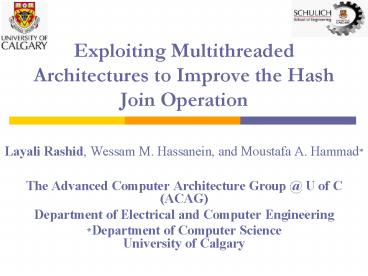Exploiting Multithreaded Architectures to Improve the Hash Join Operation - PowerPoint PPT Presentation
Title:
Exploiting Multithreaded Architectures to Improve the Hash Join Operation
Description:
Exploiting Multithreaded Architectures to Improve the Hash Join Operation Layali Rashid, Wessam M. Hassanein, and Moustafa A. Hammad* – PowerPoint PPT presentation
Number of Views:116
Avg rating:3.0/5.0
Title: Exploiting Multithreaded Architectures to Improve the Hash Join Operation
1
Exploiting Multithreaded Architectures to Improve
the Hash Join Operation
- Layali Rashid, Wessam M. Hassanein, and Moustafa
A. Hammad - The Advanced Computer Architecture Group _at_ U of C
(ACAG) - Department of Electrical and Computer Engineering
- Department of Computer Science University of
Calgary
2
Outline
- The SMT and the CMP Architectures
- The Hash Join Database Operation
- Motivation
- Architecture-Aware Hash Join
- Experimental Methodology
- Timing and Memory Analysis
- Conclusions
3
The SMT and the CMP Architectures
- Simultaneous Multithreading (SMT) multiple
threads run simultaneously on a single processor. - Chip Multiprocessor (CMP) more than one
processor are integrated on a single chip.
4
The Hash Join Database Operation
- The hash join process
- The partition-based hash join algorithm
5
Motivation
Characterizing the Grace hash join on a
multithreaded machine
- Multithreaded architectures create new
opportunities for improving essential DBMSs
operations. - Hash join is one of the most important operations
in current commercial DBMSs. - The L2 cache load miss rate is a critical factor
in main-memory hash join performance. - Therefore, we have two goals
- Utilize the multiple threads.
- Decrease the L2 miss rate.
6
Architecture-Aware Hash Join (AA_HJ)
- The R-relation index partition phase
- Tuples divided equally between threads, each
thread has its own set of L2-cache size clusters. - The build and S-relation index partition phase
- One thread builds a hash table from each
key-range
- Other threads index partition the probe relation.
7
Architecture-Aware Hash Join (contd)
- The probe phase
- The random accesses to any hash table whenever
there is a search for a potential match are a
challenge. - Threads probe hash tables with similar key range
simultaneously to increase temporal and spatial
locality.
8
Experimental Methodology
- We ran our algorithms on two machines with the
following specifications
9
Experimental Methodology (contd)
- All algorithms are implemented in C.
- We employed the built-in OpenMP C/C library to
manage parallelism. - For Machine 1 we had a 50MByte build relation and
a 100MByte probe relation. - While for Machine 2 we had 250MByte build
relation and 500MByte. - We used the Intel VTune Performance Analyzer for
Linux 9.0 to collect the hardware events.
10
AA_HJ Timing Results
- We achieved speedups ranging from 2 to 4.6
compared to Grace hash join on Quad Intel Xeon
Dual Core server (Machine 2). - Speedups for the Pentium 4 with HT ranges between
2.1 to 2.9 compared to Grace hash join.
- PT Copy-partitioning hash join
- NPT Non-partitioning hash join
- Index PT Index-partitioning hash join
- 2, 4, 8, 12 or 16 is number of threads
11
Memory-Analysis for Multithreaded AA_HJ
- A decrease in L2 load miss rate is due to the
cache-sized index partitioning, constructive
cache sharing and Group Prefetching. - A minor increase in L1 data cache load miss rate
from 1.5 to 4 on Machine 2.
12
Conclusions
- Revisiting the join implementation to take
advantage of state-of-the-art hardware
improvements is an important direction to boost
the performance of DBMSs. - We emphasized pervious findings that the hash
join is bound by the L2 miss rates, which range
from 29 to 62. - We proposed an Architecture-Aware Hash Join
(AA_HJ) that relies on sharing critical
structures between working threads at the cache
level. - We find that AA_HJ decreases the L2 cache miss
rate from 62 to 11, and from 29 to 15 for
tuple size 20Bytes and 140Bytes, respectively.
13
- The End
14
Time Breakdown Comparison (Machine 2)































